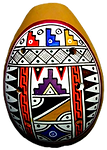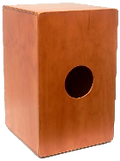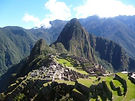
PERU INFO




Home > About Peru > Culture > Music and dances
About Peru
Music and dances
Typical instruments
The ancient Peruvian civilizations have left us instruments such as:
Quena
It is a traditional flute of the Andes, initially made of bones and now of wood or cane.

Zampoña
The pan flute is typical of Peruvian music sound, consisting of five or more pipes of gradually increasing length, made of wood or cane.

Ocarina
Little wind instrument native to South America and used by Maya and Inca cultures. In Peru, is shaped like an egg, made from clay and usually decorated with typical Andean designs in bright colors.
Later other instruments has been developed:

Cajón
It is a wooden box-shaped percussion instrument with a sound hole on the back side, the player sits astride the box slapping the front with the hands or fingers. It is of Afro-Peruvian origin.

Charango
It is a small Andean instrument with 10 strings. Originally made with armadillo shell, but today prohibited because it is an animal in danger of extinction, today made of wood.
Cajita
Rhythmic percussion instrument developed in Peru, the "little box" is part of the identity of Afro-Peruvian communities of the Central Coast. This instrument has been declared a national heritage of Peru in 2007.
Andean music
In Peru there are a large variety of songs and dances.
El Cóndor pasa
The best known Andean melody, is an orchestral musical piece from an opera writen in 1913 by the Peruvian composer Daniel Alomía Robles born in Huánuco (central Andes) and son of a French immigrant.
This song, declared National Cultural Heritage in 2004, was popularized worldwide by Simon & Garfunkel in 1970 (If I could).
Cumbia peruana
A mix of Andean huayno and cumbia pop.
Diablada
The Dance of the Devils is traditional of Altiplano in Bolivia y Peru, caracterized by masks and costumes very striking, representing the struggle between the evil and the good.
Huaylas
Is a dance very lively and cheerful, characterized by the energy and jumping of the dancers.
Music of the coast
Marina norteña
Declared National Heritage of Peru in 1986, Marinera is a graceful and romantic couple's dance that uses handkerchiefs as props, is an elegant and stylized reenactment of a courtship, the woman dances completely barefoot, and the man wear poncho and wide straw hat. There are several varieties: the Marinera Limeña slower and very elegant and the Marinera Serrana (from the highland) of melancholy character.
Vals criollo or Peruvian Walz
The Creole Walz is an adaptation of the European waltz with guitar and cajón and faster tempo. The Peruvian waltz gained widespread popularity in Latin America throughout the 1930s and 1950s and the famed French singer Edith Piaf interpreted a Peruvian waltz called "La foule" (the Crowd) composed by the Argentine Angel Cabral. The best representative of vals criollo was the singer Chabuca Granda with the famous song "la Flor de Canela" (the Cinnamon Flower).
Afro-Peruvian music
Very popular from Lima to Nasca, the most emblematic instrument is the cajón. Unique for his cheerful dances where participate children and adults with rhythmic hip movements and vigorous stamping.
Classical music
Juan Diego Flórez
Operatic tenor internationally recognized, is one of the best opera singers in the world, named as his successor by Luciano Pavarotti and considered by Placido Domingo as "the greatest light-lyric tenor of all time".
Ima Sumac
“How Beautiful!” in quechua
His real name was Zoila Augusta Emperatriz Chavarri del Castillo, claimed that she was directly descended from Inca Atahualpa, confirmed by the Peruvian government in 1946.
Peruvian soprano, she became an international success in the 50s based on her extraordinarily vocal range, of slightly over four octaves from E2 to B♭7, from coloratura soprano to baritone. She was the only one who managed to triple coloratura which is the chirping of birds.
Ima Sumac has his name inlaid in the Hollywood Walk of Fame.
Actual music
Eva Ayllón
María Angélica Ayllón Urbina is currently the best singer of Peruvian Walz and Afro-Peruvian music.
Gianmarco
The best-known Peruvian singer-songwriter for 20 years, has sold thousands of records and also has written numerous songs for famous artists such as Marc Anthony, Cristian Castro, Alejandro Fernandez, Gloria Estefan, etc.
Pedro Suárez Vértiz
Is a musician that fuses rock, pop and folk music, one of the largest Peruvian disks sellers.
Libido
It is the greatest Peruvian rock band today, winners of MTV Awards in 2002 and 2003.
Mar de Copas
Alternative rock band since almost 20 years.
Peru











